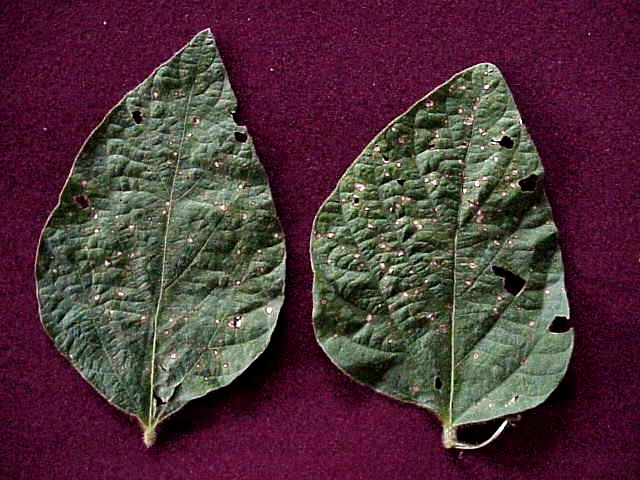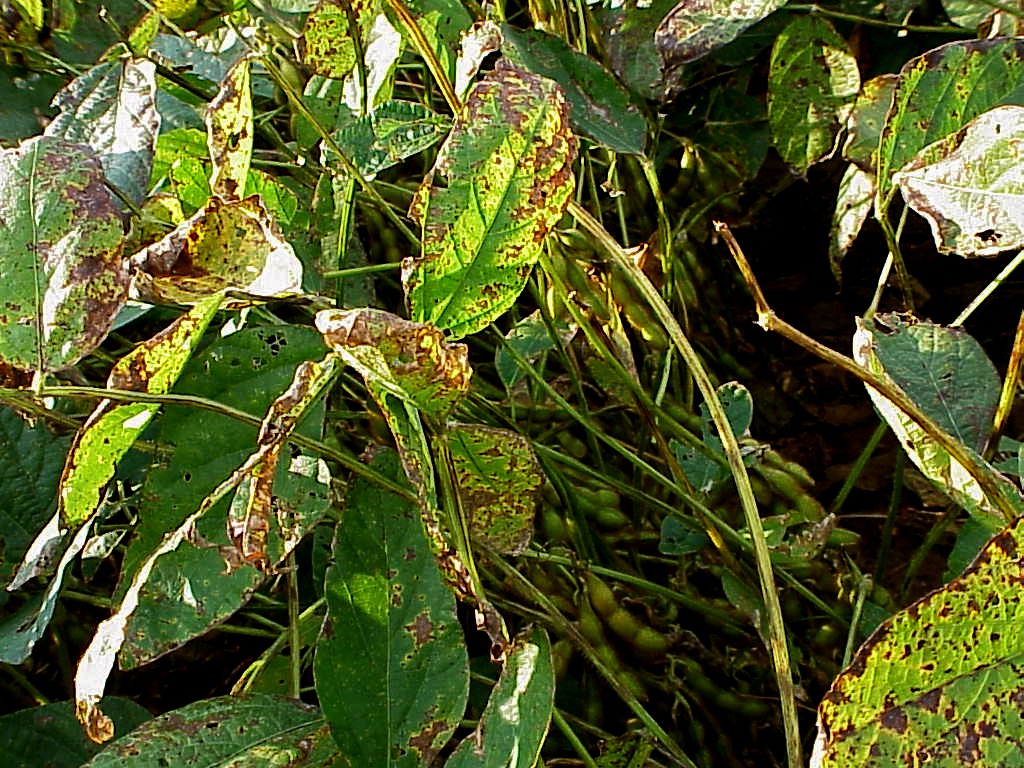Ten years ago, few farmers considered applying foliar fungicides for soybeans. These crop protection products had their home with higher-value crops such as vegetables and peanuts, where a return on investment was more likely. But with soybean futures topping $16, more growers are using fungicides to protect their soybeans from common diseases and hopefully to increase yields.
The question that is still plaguing nearly everyone is will the fungicides pay for themselves this year? The answer is really quite simple – We Don’t Know! Why don’t we know? First, the fungicides that effectively control our most common soybean diseases, the strobilurin fungicides (e.g., Headline, Quadris, etc.) are preventative. In other words, they must be applied before the disease develops. So, we’re applying a chemical to prevent a disease that may or may not progress to yield-reducing levels. Unfortunately, our ability to predict soybean disease development is not very good. Therefore, we rely on results from applied research, experience, and the probability of getting a response.
How likely are we to get a response to fungicides in Virginia? We regularly test fungicides on soybean and have built up a fairly large database. While disease incidence is reduced with fungicide application, a significant yield response occurs only about 1/3 of the time. The average yield response is 3 to 4 bushels per acre, regardless of whether we average over only experiments with significant responses or over all experiments. We’ve seen yield increases up to 12-14 bushels, but that type of response is rare. So, if you can average 3 to 4 bushels per acre over all acres, then a fungicide will likely pay for itself – unless we experience one of those years where disease is nearly absent (remember how dry it was last year?). If there’s no disease, we’ve wasted our money.
Although we do not yet have an effective weather model (such as is being used in peanut) that will guarantee success, we can make an informed, although not perfect, decision. We must remember t hat three conditions must be present in order for a disease to develop: 1) a susceptible host; 2) the pathogen; and 3) a conducive environment. This concept is commonly referred to as the plant disease triangle. If any of these three is missing, then the disease will not develop. We have the host – soybean. And we usually have some yield-robbing pathogens present – especially the Cercospora species. But the variety used must be susceptible to the pathogen. This includes two things: genetics and stage of soybean development. From the genetic standpoint, we have many varieties with resistance to frogeye leaf spot (Cercospora sojina), probably the most damaging disease that is annually present in Virginia.
hat three conditions must be present in order for a disease to develop: 1) a susceptible host; 2) the pathogen; and 3) a conducive environment. This concept is commonly referred to as the plant disease triangle. If any of these three is missing, then the disease will not develop. We have the host – soybean. And we usually have some yield-robbing pathogens present – especially the Cercospora species. But the variety used must be susceptible to the pathogen. This includes two things: genetics and stage of soybean development. From the genetic standpoint, we have many varieties with resistance to frogeye leaf spot (Cercospora sojina), probably the most damaging disease that is annually present in Virginia.  So, if you’re using a frogeye leaf spot resistant variety, response to fungicides is less likely. Certain varieties are more susceptible to cercospora blight (Cercospora kikuchii); some are less susceptible. But few have true resistance. Cercospora blight is likely most responsible for yield loss to to foliar disease and the reason that fungicides prevent soybean yield losses in Virginia. Regarding stage of development, soybean disease usually appears after full flower (R2) and the soybean are just beginning to pod (R3). This can be attributed to a larger canopy at this stage (which is related to the environment side of the triangle – see below discussion), but may also be related to physiological changes taking place in soybeans as plants transition from vegetative to reproductive growth. So if the pathogen is present on a susceptible host, there is a greater likelihood that a disease will develop. Still, the environment has to be right.
So, if you’re using a frogeye leaf spot resistant variety, response to fungicides is less likely. Certain varieties are more susceptible to cercospora blight (Cercospora kikuchii); some are less susceptible. But few have true resistance. Cercospora blight is likely most responsible for yield loss to to foliar disease and the reason that fungicides prevent soybean yield losses in Virginia. Regarding stage of development, soybean disease usually appears after full flower (R2) and the soybean are just beginning to pod (R3). This can be attributed to a larger canopy at this stage (which is related to the environment side of the triangle – see below discussion), but may also be related to physiological changes taking place in soybeans as plants transition from vegetative to reproductive growth. So if the pathogen is present on a susceptible host, there is a greater likelihood that a disease will develop. Still, the environment has to be right.
What is the right environment? Temperatures ranging from 60 to 85 F in periods with moisture provided by rainfall, dew, or high relative humidity is usually required. The greater number of days that these conditions are met, the more disease there will be. The weather service is pretty good at predicting temperatures, but not so great with rainfall. Additionally, even if rainfall is predictable, the environment within the soybean canopy (micro-environment) is usually what matters most. A tall soybean crop that has completely closed its canopy and is growing in good soil moisture will result in a micro-environment more conducive to disease development than a short crop that has not closed the canopy and is growing in a relatively dry soil.
In summary, all three conditions shown on the disease triangle must be present for a disease to develop to yield-robbing levels. We do not yet have a good model to predict common soybean diseases – but we are working on it. Until such a model is developed, Dr. Pat Phipps and I suggest the following guidelines on whether or not to spray a foliar fungicide on soybeans:
- Soybeans are growing well, have a full canopy, and are in the R3 (beginning pod) to R5 (beginning seed) stage. Research indicates that applying fungicides at R3 is better than later stages. Note that most fungicides cannot be legally applied after they have reached the R6 (full-seed) stage.
- Daily air temperatures averaging between 60 and 77 F and accumulations of rainfall were ≥ 0.5 inches in the previous 5 days or ≥ 1.0 inches in the previous 10 days, or periods of relative humidity were ≥ 95% for ≥ 12 hours per day. The greater number of days that these conditions are met, the greater likelihood for a response to fungicide application.
When soybeans were $5 to 6 per acre, very little foliar fungicide was being applied to soybean. However with today’s prices, yield is king; therefore, a small yield increases resulting from an external input such as foliar fungicides can be cost effective.




